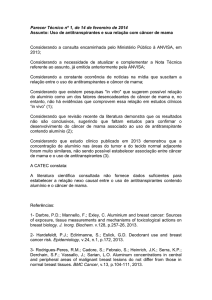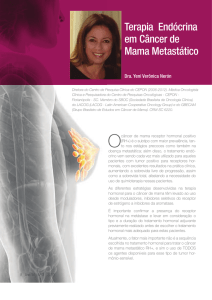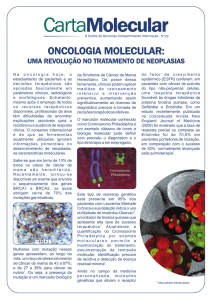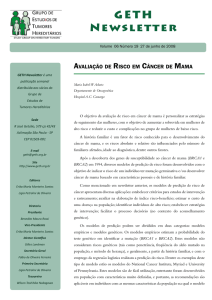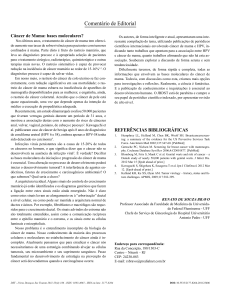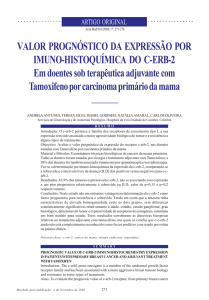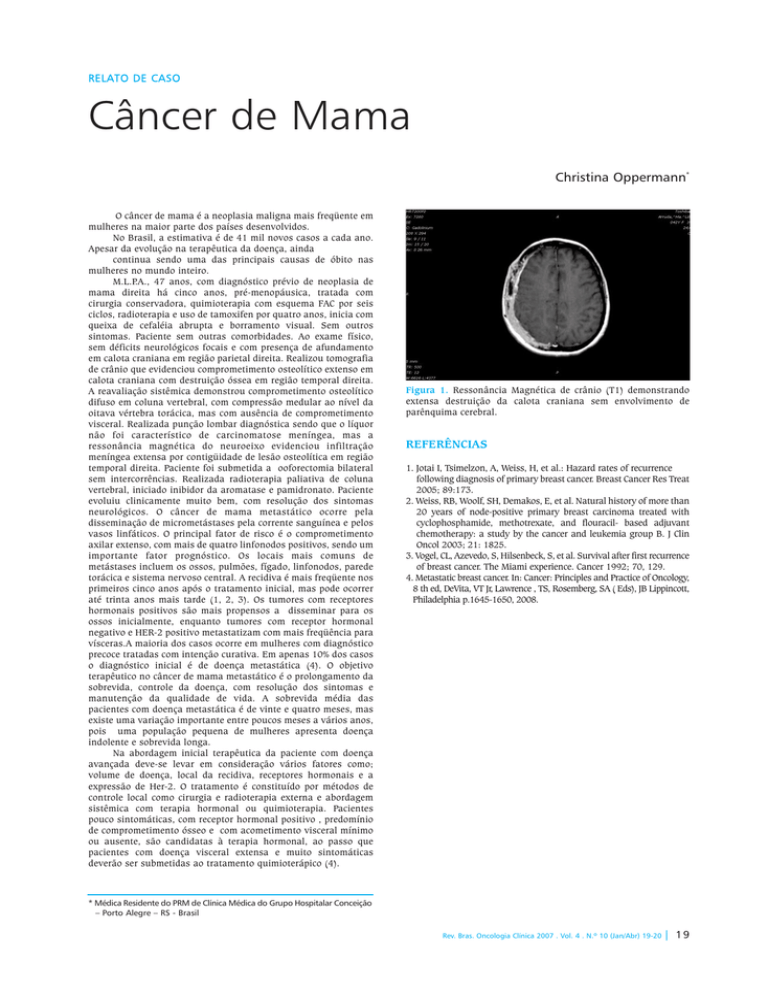
RELATO DE CASO Câncer de Mama Christina Oppermann* O câncer de mama é a neoplasia maligna mais freqüente em mulheres na maior parte dos países desenvolvidos. No Brasil, a estimativa é de 41 mil novos casos a cada ano. Apesar da evolução na terapêutica da doença, ainda continua sendo uma das principais causas de óbito nas mulheres no mundo inteiro. M.L.P.A., 47 anos, com diagnóstico prévio de neoplasia de mama direita há cinco anos, pré-menopáusica, tratada com cirurgia conservadora, quimioterapia com esquema FAC por seis ciclos, radioterapia e uso de tamoxifen por quatro anos, inicia com queixa de cefaléia abrupta e borramento visual. Sem outros sintomas. Paciente sem outras comorbidades. Ao exame físico, sem déficits neurológicos focais e com presença de afundamento em calota craniana em região parietal direita. Realizou tomografia de crânio que evidenciou comprometimento osteolítico extenso em calota craniana com destruição óssea em região temporal direita. A reavaliação sistêmica demonstrou comprometimento osteolítico difuso em coluna vertebral, com compressão medular ao nível da oitava vértebra torácica, mas com ausência de comprometimento visceral. Realizada punção lombar diagnóstica sendo que o líquor não foi característico de carcinomatose meníngea, mas a ressonância magnética do neuroeixo evidenciou infiltração meníngea extensa por contigüidade de lesão osteolítica em região temporal direita. Paciente foi submetida a ooforectomia bilateral sem intercorrências. Realizada radioterapia paliativa de coluna vertebral, iniciado inibidor da aromatase e pamidronato. Paciente evoluiu clinicamente muito bem, com resolução dos sintomas neurológicos. O câncer de mama metastático ocorre pela disseminação de micrometástases pela corrente sanguínea e pelos vasos linfáticos. O principal fator de risco é o comprometimento axilar extenso, com mais de quatro linfonodos positivos, sendo um importante fator prognóstico. Os locais mais comuns de metástases incluem os ossos, pulmões, fígado, linfonodos, parede torácica e sistema nervoso central. A recidiva é mais freqüente nos primeiros cinco anos após o tratamento inicial, mas pode ocorrer até trinta anos mais tarde (1, 2, 3). Os tumores com receptores hormonais positivos são mais propensos a disseminar para os ossos inicialmente, enquanto tumores com receptor hormonal negativo e HER-2 positivo metastatizam com mais freqüência para vísceras.A maioria dos casos ocorre em mulheres com diagnóstico precoce tratadas com intenção curativa. Em apenas 10% dos casos o diagnóstico inicial é de doença metastática (4). O objetivo terapêutico no câncer de mama metastático é o prolongamento da sobrevida, controle da doença, com resolução dos sintomas e manutenção da qualidade de vida. A sobrevida média das pacientes com doença metastática é de vinte e quatro meses, mas existe uma variação importante entre poucos meses a vários anos, pois uma população pequena de mulheres apresenta doença indolente e sobrevida longa. Na abordagem inicial terapêutica da paciente com doença avançada deve-se levar em consideração vários fatores como; volume de doença, local da recidiva, receptores hormonais e a expressão de Her-2. O tratamento é constituído por métodos de controle local como cirurgia e radioterapia externa e abordagem sistêmica com terapia hormonal ou quimioterapia. Pacientes pouco sintomáticas, com receptor hormonal positivo , predomínio de comprometimento ósseo e com acometimento visceral mínimo ou ausente, são candidatas à terapia hormonal, ao passo que pacientes com doença visceral extensa e muito sintomáticas deverão ser submetidas ao tratamento quimioterápico (4). Figura 1. Ressonância Magnética de crânio (T1) demonstrando extensa destruição da calota craniana sem envolvimento de parênquima cerebral. REFERÊNCIAS 1. Jotai I, Tsimelzon, A, Weiss, H, et al.: Hazard rates of recurrence following diagnosis of primary breast cancer. Breast Cancer Res Treat 2005; 89:173. 2. Weiss, RB, Woolf, SH, Demakos, E, et al. Natural history of more than 20 years of node-positive primary breast carcinoma treated with cyclophosphamide, methotrexate, and flouracil- based adjuvant chemotherapy: a study by the cancer and leukemia group B. J Clin Oncol 2003; 21: 1825. 3. Vogel, CL, Azevedo, S, Hilsenbeck, S, et al. Survival after first recurrence of breast cancer. The Miami experience. Cancer 1992; 70, 129. 4. Metastatic breast cancer. In: Cancer: Principles and Practice of Oncology, 8 th ed, DeVita, VT Jr, Lawrence , TS, Rosemberg, SA ( Eds), JB Lippincott, Philadelphia p.1645-1650, 2008. * Médica Residente do PRM de Clínica Médica do Grupo Hospitalar Conceição – Porto Alegre – RS - Brasil Rev. Bras. Oncologia Clínica 2007 . Vol. 4 . N.º 10 (Jan/Abr) 19-20 | 19 Case Report Breast Cancer Christina Oppermann* The breast cancer is the neoplasia most frequent in women in most developed countries. In Brazil, the estimate is 41 thousand new cases every year. Despite the developments in the treatment of disease, yet remains a leading cause of death in women worldwide. M.L.P.A. 47 years old, with a previous diagnosis of breast cancer (right) five years ago, pre-menopausal, treated with conservative surgery, chemotherapy with FAC scheme for six cycles, radiotherapy and tamoxifen for four years, starting with complaints of sudden headache and visual blurring. Without another symptoms. Patient without another comorbidity. On physical examination, no focal neurological deficits and with the presence of sank in skull in right parietal region. Performed CT of skull showed extensive involvement in osteolytic skull with bone destruction. The review showed systemic involvement in diffuse osteolytic vertebral column with spinal cord compression at the eighth thoracic vertebra, but with absence of visceral involvement. Performed diagnostic lumbar puncture and the CSF was not characteristic of meningeal carcinomatosis, but the magnetic resonance of neuroaxis showed extensive meningeal infiltration by contiguity of osteolytic lesion in right temporal region. Patient underwent bilateral oophorectomy without complications. Performed palliative radiotherapy of spine, initiated aromatase inhibitor and pamidronate. Patient developed clinically well, with resolution of neurological symptoms. The metastatic breast cancer occurs by the spread of micrometastases into the bloodstream and the lymphatic vessels. The main risk factor is the extensive axillary involvement with more than four positive lymph nodes, and an important prognostic factor. The most common sites of metastases include the bones, lungs, liver, lymph nodes, chest wall and central nervous system. Recurrence is more frequent in the first five years after initial treatment, but can occur up to thirty years later (1, 2, 3). The tumors with hormone receptor positive are more likely to spread to the bones initially, while tumors with hormone receptor negative and HER-2 positive metastasize more often to vísceras.A most cases occur in women with early treated with curative intent. In only 10% of cases the initial diagnosis was metastatic disease (4). The goal of therapy in metastatic breast cancer is the prolongation of survival, disease control, with resolution of symptoms and maintaining quality of life. The median survival of patients with metastatic disease is the twentyfour months, but there is important variation between a few months to several years, since a small population of women presenting indolent disease and long survival. In the initial therapeutic approach of patients with advanced disease should be taken into consideration several factors such as, volume of disease, local recurrence, and hormone receptor expression of Her-2. Treatment consists of methods of local control as surgery and external radiotherapy and systemic approach to hormonal therapy or chemotherapy. Little symptomatic patients with hormone receptor positive, prevalence of bone involvement and visceral involvement with minimal or absent, are candidates for hormonal therapy, while patients with extensive visceral and very symptomatic should be submitted to chemotherapy (4). * Fellow in Internal Medicine of the Grupo Hospitalar Conceição – Porto Alegre – RS - Brasil 2 0 | Rev. Bras. Oncologia Clínica 2007 . Vol. 4 . N.º 10 (Jan/Abr) 19-20 Fig. 1. Magnetic Resonance Imaging of skull (T1) showing extensive destruction of the skull without involvement of brain parenchyma. REFERÊNCES 1. Jotai I, Tsimelzon, A, Weiss, H, et al.: Hazard rates of recurrence following diagnosis of primary breast cancer. Breast Cancer Res Treat 2005; 89:173. 2. Weiss, RB, Woolf, SH, Demakos, E, et al. Natural history of more than 20 years of node-positive primary breast carcinoma treated with cyclophosphamide, methotrexate, and flouracil- based adjuvant chemotherapy: a study by the cancer and leukemia group B. J Clin Oncol 2003; 21: 1825. 3. Vogel, CL, Azevedo, S, Hilsenbeck, S, et al. Survival after first recurrence of breast cancer. The Miami experience. Cancer 1992; 70, 129. 4. Metastatic breast cancer. In: Cancer: Principles and Practice of Oncology, 8 th ed, DeVita, VT Jr, Lawrence , TS, Rosemberg, SA ( Eds), JB Lippincott, Philadelphia p.1645-1650, 2008.

